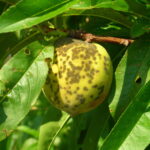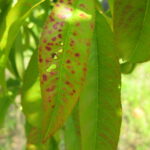After what can only be described as a very early spring, we are entering the unusual situation of worrying about fire blight in April. Summer-like weather, rainfall, thunderstorms and hail mean that growers should be very concerned about fire blight. It is important to note that the fire blight pathogen, Erwinia amylovora, is always present at some level on the surface of most apple trees, and on other rosaceous plants (Fig. 1). After the crop loss that most of the state experienced last year, heavier bloom, and warm, wet weather has the potential to make for catastrophic fire blight in 2021. Never forget that fire blight appears suddenly and spreads quickly—causing significant damage in a matter of days, but taking weeks, months or even years to get under control.
Fire blight infections start primarily at the flowers, although bacteria can enter and establish through wounds caused by hail or high winds associated with summer storms (referred to as shoot blight or trauma blight. Note: shoot blight is often the result of carryover flower infections from the previous year). How much the bacteria spread has a lot to do with type of cultivar infected: Red Delicious, Honeycrisp, McIntosh, and Empire are more resistant to fire blight, compared to cultivars like Crispin (Mutsu), Fuji, Gala, Ginger Gold, Gravenstein, Jonathan, Ida Red, and Lodi that are much more susceptible. How much the bacteria spread also has a lot to do with the age of the tree, with younger trees more susceptible than older ones. Finally, excessive N fertilization, especially if ammoniacal nitrogen is used, can make even ‘resistant’ cultivars susceptible to fire blight.
Susceptible cultivars serve as reservoirs for the fire blight bacteria. Years ago, at our research plot at Meigs, we witnessed a severe outbreak of fire blight in the Fuji/Gala/Jonathan/Ruby Jon planting. This block of super susceptible cultivars acted as a source of inoculum for other cultivars, quickly spreading throughout the block, and then radiating out to those trees adjacent to or downwind from the Fuji/Gala/Jonathan/Ruby Jon planting.
If your orchard has a history of fire blight, I would strongly encourage you to consider applying Apogee or Kudos(Prohexadione-Ca). Apogee is a growth regulator that does not directly kill the fire blight bacterium, but reduces shoot growth, thereby increasing plant resistance by reducing host vigor. Apogee suppresses apple shoot growth when applied near petal fall as a single spray, or as several applications over time. Apple response to Apogee depends upon the cultivar, timing, rate of application, crop load, and even geographical location. Regardless of this variability, Apogee remains the best management tool available for controlling the shoot blight phase of fire blight that growers may be faced with after a freeze.
For those at tight cluster through pink: Assuming trees have less than 3” of new growth, early applications of apogee will help prevent fire blight in what is shaping up to be another challenging year. With temperatures flirting with 80 today, fire blight needs to be on your radar.
For those at bloom: Now is the time to protect blossoms with streptomycin. To date, we have not identified any streptomycin -resistant fire blight bacteria. With proper stewardship, we can do a lot to keep it that way. Apply streptomycin with the first (king) bloom, followed by full bloom and possibly petal fall, depending how quickly this stage transpires.
Apple Scab
Now is the time to do a quick scab scouting. I did a quick survey in our unsprayed research plots out at Meig’s Farm and could not find scab (I also didn’t have my readers with me, so…). I’m sure it’s there—I’m probably too short to reach it. This orchard, or at least the blocks I work in, would qualify as a high-inoculum orchard with serious fungicide resistance issues. Because the trees are so far along, infection courts will include the upper and lower leaf surface, petals, green shoots, developing fruit—you name it. It will take about 10 to 17 days from the time of infection by the apple scab pathogen until symptom development occurs, whereupon we’ll see feathery olive to blackish, velvety scab lesions that drive secondary infection. I’m really excited about our scab and bitter rot trials this year, which include a head-to-head trial of different SDHI fungicides, because, inquiring minds want to know!
Using DMIs at petal fall and first cover will protect not only against scab (especially using Inspire Super, which we found was effective against highly Nova/Rally-resistant isolates) but will also protect against powdery mildew and the juniper rusts. Dodine can be applied no later than pink, and will only work against scab. Note: Inspire does not seem to have the juniper rust or powdery mildew control of Rally. Thus, you may wish to use Inspire for petal fall and revert back to Rally for first cover, where Rally resistant scab is not an issue.
Stone Fruit:
Peach Scab (Fig. 2). Timing sprays to early shuck-split and shuck-fall are essential for peach scab control. Apply the first spray about one week after petal fall and continue to spray on a 7 to 14-day interval until 40 days before harvest. If you’re using Bravo for brown rot control (in addition to scab), be sure to stop at shuck-split, or things can get ugly. See the Midwest Fruit Pest Management Guide for further information at https://ag.purdue.edu/hla/Hort/Documents/ID-465.pdf
Bacterial Spot
Unlike peach scab, which only attacks the fruit, bacterial spot attacks the fruit, leaves (Fig. 3), and newly developed twigs and shoots, usually around the time of petal fall to shuck split. Symptoms of bacterial fruit spot are tiny, purple to black specks on peaches with yellow halos, and as water-soaked spots on nectarines and other smooth skinned Prunus spp. Later, the skin is “broken” and the flesh beneath the spot becomes sunken. These lesions do not appear velvety, like peach scab. Foliar spots are usually angular, delimited by leaf veins. In the next few weeks, they become watersoaked and may eventually fall out, creating a “shot hole” type appearance. Mycoshield and Flame-out are labeled for use from petal fall to shuck split. Captan or a “too late” copper application can cause damage that can be confused with bacterial spot.
Brown Rot
Prevent infection by the proper application of fungicides prior to shuck-split; the protectant fungicides Chlorothalonil (Bravo, Echo) and Captan provide the best protection against brown rot. For those of you in northern Indiana, from pink to petal fall, Topsin-M (FRAC 1), Rovral(FRAC 2), Quash, Rally Indar. Tilt, Elite (all FRAC 3), Fontelis (FRAC 7), Pristine, Merivon or Luna Sensation(FRAC 11+7), Elevate (FRAC 17), are all labeled for use. Unlike the Eastern US, we have not seen any evidence, nor have I heard of any reports of Topsin-M resistance in the brown rot fungus, so feel free to incorporate Topsin-M in your rotations. Rotating different classes of fungicides is essential for good resistance management, and will hopefully allow us to continue using Topsin-M, and other systemic fungicides for a long-time. Check out the Indiana peach disease management guide at https://www.extension.purdue.edu/extmedia/BP/BP-208-W.pdf
Blueberries
Mummyberry
Where blossoms are open, apply Indar or Pristine to prevent mummy berry infection from occurring. Flowers are most susceptible immediately after opening with susceptibility decreasing over time. As pollination increases, so increases the risk of infection as bees vector spores from infected plants to susceptible flowers. Infection begins when the spores germinate on the stigma of the flower and then grows just like a pollen tube through the pistil into the ovaries. Once the fungus reaches the ovaries, it colonizes in the developing berry and can be seen as white fungal growth if the green berries are cut open.
Phomopsis
Phomopsis canker and twig blight, caused by the fungus Phomopsis vaccinii, has been and continues to be a serious problem in Indiana (Fig. 4). Our mild winter means we wouldn’t anticipate this being a problem this year, and growers with a history of this disease can try to get a jump on eradicating what phomopsis they do have, and really protecting the new green growth, reducing the risk for future problems.
If you haven’t already, or even if you started, continue to prune out dead and diseased twigs, even if they are green, and as they develop! Destroy all infected plant material. Protect the new growth from mechanical or chemical injury—these injuries allow the fungus to get into the plant!
Use fungicides to protect new canes from infection. The following fungicides are labeled:
-
- Captan or
- Ziram
- Indar
- Pristine
- Flint Extra (excluding high bush)
- Luna Sensation (excluding high bush)
- Merivon
- Miravis Prime
- Quash
- Switch
These fungicides should be applied every 10-14 days from early pink bud through pea-size fruit. Under high pressure, fungicides should be used through August, as spore activity of Phomopsis ceases around September.
- Figure 1. Fire blight ooze from last year’s canker. Photo by George Sundin
- Figure 2. Peach scab is often misdiagnosed for bacterial spot. Photo by Janna Beckerman.
- Figure 3. Bacterial spot, cause by the bacterium Xanthomonas, is also called shot hole. Photo by Janna Beckerman.
- Figure 4. Phomopsis on blueberry. Photo by Mary Ann Hansen.



